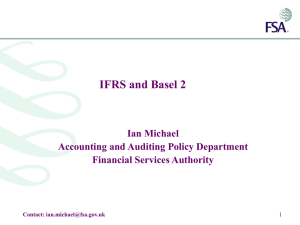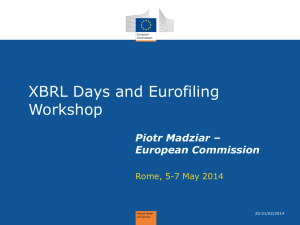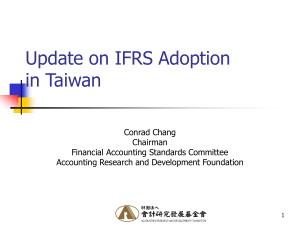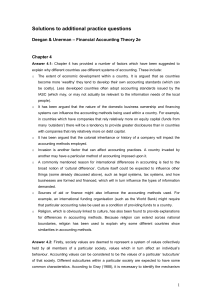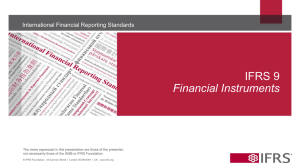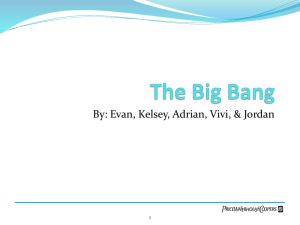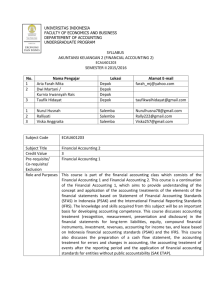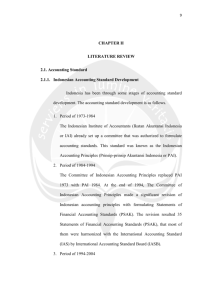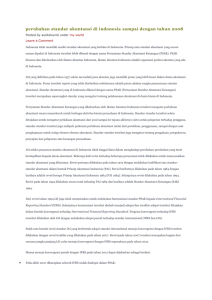Positive Accounting Theory In Predicting
advertisement
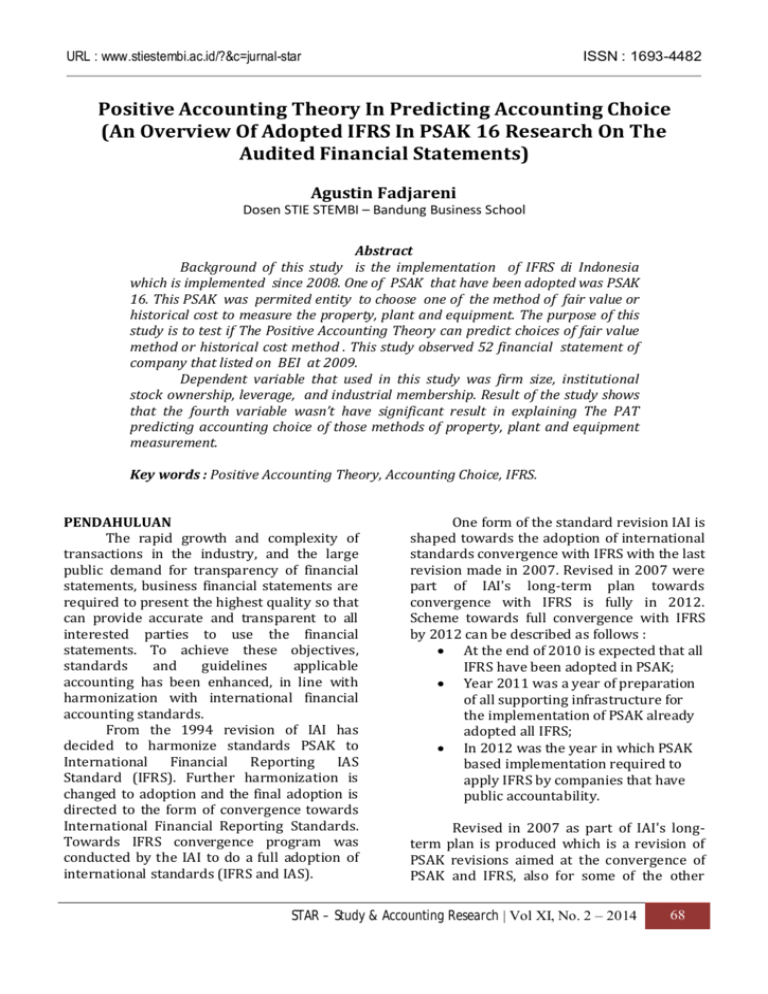
URL : www.stiestembi.ac.id/?&c=jurnal-star ISSN : 1693-4482 Positive Accounting Theory In Predicting Accounting Choice (An Overview Of Adopted IFRS In PSAK 16 Research On The Audited Financial Statements) Agustin Fadjareni Dosen STIE STEMBI – Bandung Business School Abstract Background of this study is the implementation of IFRS di Indonesia which is implemented since 2008. One of PSAK that have been adopted was PSAK 16. This PSAK was permited entity to choose one of the method of fair value or historical cost to measure the property, plant and equipment. The purpose of this study is to test if The Positive Accounting Theory can predict choices of fair value method or historical cost method . This study observed 52 financial statement of company that listed on BEI at 2009. Dependent variable that used in this study was firm size, institutional stock ownership, leverage, and industrial membership. Result of the study shows that the fourth variable wasn’t have significant result in explaining The PAT predicting accounting choice of those methods of property, plant and equipment measurement. Key words : Positive Accounting Theory, Accounting Choice, IFRS. PENDAHULUAN The rapid growth and complexity of transactions in the industry, and the large public demand for transparency of financial statements, business financial statements are required to present the highest quality so that can provide accurate and transparent to all interested parties to use the financial statements. To achieve these objectives, standards and guidelines applicable accounting has been enhanced, in line with harmonization with international financial accounting standards. From the 1994 revision of IAI has decided to harmonize standards PSAK to International Financial Reporting IAS Standard (IFRS). Further harmonization is changed to adoption and the final adoption is directed to the form of convergence towards International Financial Reporting Standards. Towards IFRS convergence program was conducted by the IAI to do a full adoption of international standards (IFRS and IAS). One form of the standard revision IAI is shaped towards the adoption of international standards convergence with IFRS with the last revision made in 2007. Revised in 2007 were part of IAI's long-term plan towards convergence with IFRS is fully in 2012. Scheme towards full convergence with IFRS by 2012 can be described as follows : At the end of 2010 is expected that all IFRS have been adopted in PSAK; Year 2011 was a year of preparation of all supporting infrastructure for the implementation of PSAK already adopted all IFRS; In 2012 was the year in which PSAK based implementation required to apply IFRS by companies that have public accountability. Revised in 2007 as part of IAI's longterm plan is produced which is a revision of PSAK revisions aimed at the convergence of PSAK and IFRS, also for some of the other STAR – Study & Accounting Research | Vol XI, No. 2 – 2014 68 URL : www.stiestembi.ac.id/?&c=jurnal-star PSAK reformat and the issuance of new PSAK. The new PSAK issued by the IAI is a set of PSAK financial transactions and recording to the share. The revised PSAK and addressed within the framework of PSAK to IFRS convergence goals. One of IFRS and IAS has been adopted is IAS 16 (PSAK 16 regarding Fix Asset). In connection with the explanation above, the authors are interested in doing research on adopted IFRS in PSAK 16 research on the audited financial statements, using the theoretical basis of accounting and positive role in influencing accounting choice on the financial statements. The reason is because IFRS gives the option to companies in determining the choice of method of historical cost or fair value, where the choice of accounting choice that will affect the reliability of financial reporting. As is known, PSAK 16 mentioned above have adopted the IFRS since 2008, so for this research was able to use the company's financial data as of December 31, 2009. The debate over the historical cost versus fair value is not a new thing in the world of accounting. Various research in the world about it as Weston (1953), who oppose fair value accounting because the cost is quite high, where public companies in the US when it requires additional disclosure of financial statements when inflation is quite high in 1970, when the first government of US implemented a fair value measurement for non financial assets, including inventorys, propertys, plants and equipments. Although the rules above withdrawn by the government of US, when inflation gets out of control, but the debate on historical cost and fair value has never stopped. Various criticisms are being dedicated to fair value method. Some of the critic said that the fair value is suspected as one of the triggers of the crisis, as claimed by the American Bankers Association in a letter addressed to the SEC in September 2008 which reads: “The problem that exist today’s financial market can be traced to many different factors. One factor that is recognized as having exacerbated these problem is fair value accounting”(Laux,2009) ISSN : 1693-4482 Similarly, Vernon (2008) in Daniel & Jung (2010) expressed his criticism of fair value accounting: “As illiquidity and procyclicality. The illiquidity criticism stems from an imbalance between supply and demand. That is the price may not reflect the true value of the item measured. This is true when as a result of severe economic recessions, market participants do not act rationally. Procyclicality occurs when the observable prices are flawed because the market is imperfect.” But Price Waterhouse Coopers (PwC) (2008b) conversely to support fair value accounting, according to PwC, fair value is the best method for most financial instruments, particularly for financial assets, and consideration of using the fair value method is most effective in reflecting the economic reality of the condition market. When the fair value method to be an option, many research indicate that the company did not choose this option. The focus of research on the fair value option is usually connected with the implementation of IFRS. The research of Demaria and Dufour (2007) showed that the 120 companies that go public in France, only 4 companies that choose to IAS 16 fair value. According to Demaria and Dufour (2007), most of the fair value option was chosen by the group of industries from financial institutions. Furthermore the option fair value related to the size of the company, the CEO's compensation, institutional ownership and cross listing. The results also prove that the Accountant in France prefer to stay abreast for the principle of conservatism then the newly introduced IFRS standards. Other research about the fair value option by Daniel Jung, et al (March 2010), which examined the reaction of the CFO to the fair value option for non-financial assets and long-term debt. The result, said that company size, profitability and leverage levels affect the response CFO (Chief Financial Officer) against fair value option. Response the CFO’s who refuse to choose the option fair value because fair value is causing costs to be high, while the CFO’s who agree to choose fair value assumes that fair value provides a better picture for the company. STAR – Study & Accounting Research | Vol XI, No. 2 – 2014 69 URL : www.stiestembi.ac.id/?&c=jurnal-star In this particular research examines the application of fair value as an option in PSAK 16 (fixed assets) which has adopted IFRS since 2008. The test will use the variables: company size, leverage level, membership industrial and institutional ownership. Variables derived from the positive theory of accounting is a measure of corporate size and financial leverage variables while the other two authors add the reference to a previous study conducted by Demaria & Dufour (2010). LITERATURE REVIEW Positive Accounting Theory Positive Accounting Theory is currently used as a basis for research of Accounting (Accounting Choices). Jensen (1976) states that: “ The Positive Accounting Theory is managed to explain why accounting is what it is, why accountant do want they do and what effects these phenomena have on people and resources utilization.” Belkoui (1992) states that: “The central ideal of the positive approach is to develop hypothesis about factors that influence the world of accounting practice and to test empirically the validity of these hypotheses.” Furthermore, the theory popularized by Watts and Zimmerman (1986), states that: " The accounting theory's role is to Provide Explanations for accounting practice." Suwarjono (2008, p. 20) states that : "The theory of accounting would be a set of hypothesis-hpotesis descriptive as the result of research using scientific methods tertentu.Oleh therefore, contains the entire analysis of accounting theory and its components (assumptions, definitions and hypotheses) which is used to predict and explain phenomena unttuk-symptoms or accounting events. Thus the status of accounting would be equivalent to understanding the theory of science in astronomy, economics, physics, biology and so on. The accounting theorists emulates and mimics the scientific method to develop a theory akuntansi.Mereka trying to bring in and develop the theory of accounting. They tried to carry and interpret accounting theory to the status of such a theory. ISSN : 1693-4482 Accounting theory as science is called positive accounting theory ". Fair Value The definition of Fair Value under IAS 2 of 6: “Fair value is the amount of which an asset could be exchange, or a liability settled, between knowledgeable, willing parties in an arm’s length transaction.” The use of fair value method under IAS, are mandatory and also there is an option like used in IAS 16, propertys, plants and equipments. In Indonesia, has adopted in PSAK 16, where the fair value in PSAK is an option and not a mandatory. Generally, fair value accounting is expected to present the basic and relevant value for the asset and liability. But according to Leonard (2008), when the economy in recession or experiencing "bubbles" then the resulting value can be misleading (misleading). Barth (2004), Penman (2007), Benston (2008) and Ryan (2008), states that fair value is irrelevant and potentially misleading for the assessment of assets used for the long term, especially when due where hargamya can be affected by the market that do not efficient, irrational investor behavior, liquidity problems, and others. Similarly, the groups that criticize the Historical Cost stated that: "Historical costs do not reflect the current fundamental value of an asset either. Therefore, It Might be better to use market values, even if the markets are illiquid, and to supplement with additional disclosures Them eg, about the fundamental value of the assets held to maturity Pls. "(Leux and Leuz, 2009). Among the researchers who support, Herrman and al (2005) in Demaria and Dufour (2007), his opinion as follows: "Fair value measures for property, plant and equipment are superior to historical cost based on the characteristic of predictive value, feedback value, timeliness, neutrality, representational faithfulness, comparability and consistency. Verifiability appears to be the sole qualitative characteristic favoring historical cost over fair value. " STAR – Study & Accounting Research | Vol XI, No. 2 – 2014 70 URL : www.stiestembi.ac.id/?&c=jurnal-star Research Framework adn Hypothesis The research that conducted by BASU (2001) found that small firms are more conservative than the big companies. Small companies are more risky than large firms because the return more volatile, so that small firms will be more motivated to adopt conservative accounting as a way to avoid such volatility. H1: There is a positive relationship between firm size and the fair value option The companies that often use debt to his finance typically requires an independent appraisal in order to get the value of collateral for credit facilities (Christensen and Nikolaev, 2009). Debtors typically interested in using the fair value for the calculation of their assets because they want to know the value of the liquidity of its assets. According to Christensen and Nikolaev (2009), there is a positive relationship between the adoption of fair value and financing through borrowing on the companys in UK and Germany. Watts and Zimmerman (1990) states that: "The higher the firm debt / equity ratio the more likely that managers use accounting methods ceteris paribus increase of income and equity." H2: There is a positive relationship between financial leverage with the fair value option Firth (1995) states that: "There is a positive relationship the between the level of institutional stock ownership and the debtequity ratios (debt to total assets and debt to debt plus market value of equity). Additionally, the institutional investors will from act to moderate the changes in leverage induced by changes in management's ownership”. Also Firth states: "Managers with large stock-holdings not only have a greater incentive to maintain prudent corporate debt ratios but they also, by reason of their ownership rights, have greater ability to force through policies reflect that their self-interests. " ISSN : 1693-4482 H3: There is a positive relationship between institutional stock ownership with a fair value option. Ball et al (in Basu (2001) stated that only a small influence of the industrial membership of accounting choices. As is the industrial membership in this study is the classification of industries, which will be grouped in two groups, ie groups of non-financial institutions and financial institutions group. The results of Demeria and Dufour (2007, p.21) states that financial institutions (banks and the like) would be more interested to use the fair value option, because financial institutions are trained in selling and buying investment property, so can pushing to adopt the fair value option. H4: There is positive influence of the industrial membership with an option to fair value METHODOLOGY Based on the concept, variable observed in this research are the size of the company, institutional stockownership, leverage and industrial membership. The data source used the issuer's financial statements in 2009, from companies listing on the Stock Exchange. Design of the research is an explanatory research. Data collected and analyzed using cross sectional data. Variables are observed by analyzing the company's financial statements audit for 1 (one) year, the financial statements year ended December 31, 2009. The reason for using only a single year observations on the financial statements is due to IFRS adoption of PSAK 16 has been running for one year only. The population is a company listed on the Indonesia Stock Exchange. Target population is a manufacturing and financial company, which has published financial statements at 31 December 2009. Operationalization of variabel as follows : STAR – Study & Accounting Research | Vol XI, No. 2 – 2014 71 URL : www.stiestembi.ac.id/?&c=jurnal-star ISSN : 1693-4482 Table 1 Operationalization Of variable Variable Indicator Institutional Stock % ordinary shares Ownership (X1) invested in banks, insurance companies and the Fund Manager Company size Logaritmic assets (X2) Leverage Liabilities/equity (X3) Industrial for the Finance Industry 1, membership (Z) for the others 0 (Moderating variables) Fair value option Number 1 for the fair (Y) value option, the number 0 to historical cost option X1 : Institutional Stock Ownership; X2 : Company Size; X3 : Financial Leverage; Z : Industrial membership; Y : Fair Value Option. For analyzing, statistical methods is logistic regression, because the regression of this type commonly used to solve accounting problems using the proxy option in percentages, such as research conducted by Hand & Skantz (1998), Demaria & Dufour (2007) and Daniel & Jung (2010). Demaria & Dufour (2007), citing Raffournier (1990) on the use of logistic regression is as follows: "Generally the methodology used is the probit or logit analysis, the which permits to estimate, from characteristic of firms, the probability a firm choice That one or other method". Research model are shown in figure 1. As follows : RESULT OF STUDY We present data in appendix 1. From 51 companies are, 13 companies chose the option fair value to PSAK 16 (- / + 21%). This figure is greater than the results of research Demaria & Dufour (2010) in France, which produces only a 3% only. This could prove the existence of differences between the fair values of options in Indonesian accountants with in France or can be caused by the preferences of investors, which must be proven by further research. Table 2. Data Analysis Figure 1. Research Model Based on the picture above, the position of Industrial Membership variable is moderating variables. Moderating variables is the variables that influence dependence (contigent effect) with a strong relationship variable bound and free variables (Uma have now, 2006). From the diagram above, this research model are: Y=α+β1X1+β2X2+β3X3+β4Z+β4X1Z+β5X2Z + β6X3Z+e Dependent Variable: Y2 Method: ML - Binary Probit (Quadratic hill climbing) Date: 06/14/10 Time: 20:57 Sample: 1 45 Included observations: 45 Convergence achieved after 7 iterations Covariance matrix computed using second derivatives Variable C X1 X2 X3 X1X4 X2X4 X3X4 McFadden R-squared S.D. dependent var Akaike info criterion Schwarz criterion Hannan-Quinn criter. LR statistic Prob(LR statistic) Obs with Dep=0 Obs with Dep=1 Coefficient Std. Error z-Statistic -1.016130 0.767853 -1.323340 0.006402 0.009994 0.640572 -3.66E-06 9.06E-06 -0.404147 0.029276 0.111515 0.262528 0.021460 0.020405 1.051717 0.000894 0.000623 1.434217 -5.895222 4.276204 -1.378611 0.148423 Mean dependent var 0.458368 S.E. of regression 1.334969 Sum squared resid 1.616005 Log likelihood 1.439737 Restr. log likelihood 8.030238 Avg. log likelihood 0.235896 32 Total obs 45 13 STAR – Study & Accounting Research | Vol XI, No. 2 – 2014 Prob. 0.1857 0.5218 0.6861 0.7929 0.2929 0.1515 0.1680 0.288889 0.455924 7.898928 -23.03680 -27.05192 -0.511929 72 URL : www.stiestembi.ac.id/?&c=jurnal-star ISSN : 1693-4482 Estimation Command: ========================= BINARY(D=N) Y2 C X1 X2 X3 X1X4 X2X4 X3X4 selected the option fair value. This can be explained, as follows: 1. There Another very influential factor, so the statistical test results do not support the findings. I suspect that there is a relation with the number of samples tested homogeneity of the data and the factor of investor preferences. But beyond this must be proven by further research. 2. Positive Theory Accounting in this reserach has not been able to explain to predict accounting choice. Further research is needed to repair a better model and variables that are better suited to conditions in Indonesia. 3. Researchers may also conduct further studies using other theories in accounting, which can be used to predict the accounting choice. Estimation Equation: ========================= I_Y2 = C(1) + C(2)*X1 + C(3)*X2 + C(4)*X3 + C(5)*X1X4 + C(6)*X2X4 + C(7)*X3X4 Forecasting Equation: ========================= Y2 = 1-@CNORM(-(C(1) + C(2)*X1 + C(3)*X2 + C(4)*X3 + C(5)*X1X4 + C(6)*X2X4 + C(7)*X3X4)) Substituted Coefficients: ========================= Y2 = 1-@CNORM(-(-1.01613044978 + 0.00640213357782*X1 - 3.65980035488e-06*X2 + 0.0292757266891*X3 + 0.0214602764192*X1X4 + 0.000893548546899*X2X4 - 5.89522219891*X3X4)) Interpretation of the results of data processing: 1. Mc Fadden coefficient of 0.148423, indicating that the regression results or the model used is less good. 2. There is one variable from the above model, which has bode not in accordance with the predictions of the hypothesis (variable X2 = market value). This can be caused by variations in the data obtained his figures are too wide. 3. Coeffisien associated with variables x1, x2, x3, and composite x1x4, x2x4 and x3x4 are insignificant. This is consistent with previous research conducted by Demaria & Dofour (2010), except for variable financial leverage. In the study Demaria & Dofour (2010), regression results indicate significant financial leverage variables. A possible cause of this difference is the lack of sample is used only (52 samples) only, while Demaria & Dofour using 120 samples. CONCLUSION AND SUGGESTIONS The results showed the sample in Indonesia, the fair value option has nothing to do with company size, financial leverage, institutional ownership and industrial membership. Although the results showed that there were approximately 21% of companies’ surveyed 52 companies, has REFFERENCES Armstrong, C.; M. Barth; A. Jagolinzer; and E. Riedl. “Market Reaction to Events Surrounding The Adoption of IFRS in Europe.” Working paper, Harvard Business School and Stanford University, 2007. SSRN Atanassova, Anita .”IFRS option in Bulgaria Banks: Non Numerical Disclosure Evidence University of Economics- Vama, Bulgaria, 2008 Ball, R . “IFRS: Pros and Cons for Investors.” Accounting & Business Research International Accounting Policy Forum (2006): 5–27. Banker .“The most profitable private Bank in Russia , Oct2006, Vol. 156 Issue 968, p101101, B.Christensen, Hans ,Edward Lee and Martin Walker.”Incentives or standards: What determines accounting quality changes around IFRS adoption? SSRN,2008 Blanchette, Michel “IFRS In Canada: Evolution or Revolution?” CMA Management, May2007, Vol. 81 Issue 3, p22-26 STAR – Study & Accounting Research | Vol XI, No. 2 – 2014 73 URL : www.stiestembi.ac.id/?&c=jurnal-star Boyce, Godfrey .”NZ IFRS – The Challenge Facing The Financial Services Industry”InFinsia, Nov/Dec2006, Vol. 120 Issue 5, p56-56, Brown,Phlip; Tarca, Ann. “A commentary on issues relating to the enforcement 0f International Financial Reporting Standards in the EU.” By: Brown, Philip; Tarca, Ann. European Accounting Review, May2005, Vol. 14 Issue 1, p181-212 Capkun, V.; A. Cazavan-Jeny; T. JeanJean; and L. Weiss. “Earnings Management and Value Relevance during the Mandatory Transition from Local GAAPs to IFRS in Europe.” Working paper, Georgetown University, 2008. SSRN Collins,Peter .”Tax implications of the IFRS.”. International Tax Review, May2005, Vol. 16 Issue 5, p42-42 Dargenidou, Christina; McLeay, Stuart;Raonic,Ivana. “Expected earnings growth and the cost capital: an analysis of accounting regime change in the European financial market.” Abacus, Sep/Dec2006, Vol. 42 Issue 3/4, p388-414, Dart, Lindsay. “Why banks must act now on EU hedging rules.” International Financial Law Review, Jun2003, Vol. 22 Issue 6, p20, 3p; (AN 10138152) Daske, H., L. Hail, C. Leuz, and R. Verdi. “Mandatory IFRS Reporting Around the World: Early Evidence on the Economic Consequences”University of Chicago Working Paper.2008. ISSN : 1693-4482 Elliot,A.John and Donna R.Philbrick .”Accounting Changes and Earnings Predictability Source: The Accounting Review, Vol. 65, No. 1 (Jan., 1990), pp. 157174 Published by: American Accounting Association Gebhart, Gunther. “Accounting for credit risk: are the rules setting the right incentives?” International Journal of Financial Services Management, 2008, Vol. 3 Issue 1, p24-44, Hail, L., and C. Leuz.” Capital Market Effects of Mandatory IFRS Reporting in the EU: Empirical Evidence.” Amsterdam: Netherlands Authority for the Financial Markets, 2007. Jermakowicz, Eva K; Gornik-Tomaszewski, Sylwia .”IASB Issues a Standard on FirstTime Adoption of International Financial Reporting StandardsTomaszewski, Sylwia. Bank Accounting & Finance (08943958), Dec2003, Vol. 17 Issue 1 Lang, L., and R. Stulz. “Tobin’s q, Corporate Diversification, and Firm Performance.” Journal Of Political Economy 102 (1994): 1248–80. Lilien,Steven.Martin Mellman, Victor Pastena.”Accounting Changes: Successful versus Unsuccessful Firms” Source: The Accounting Review, Vol. 63, No. 4 (Oct., 1988), pp. 642-656 Published McDonnell, John.“International Financial Reporting Standards and Revenue Recognition.” Accountancy Ireland, Dec2003, Vol. 35 Issue 6, p15-17. Demaria, S., and D. Dufour “First Time Adoption of IFRS, Fair Value Option,Conservatism: Evidence from French Listed Companies.” Working paper, Nice Sophia Antipolis University,2007. Moya,Soledad., Oliveras, Ester.“Voluntary Adoption Of IFRS In Germany: A Regulation Impact Study” . Corporate Ownership & Control, Spring2006, Vol. 3 Issue 3, p138147 Dopuch, Ncholas and Ross Watts.” Using TimeSeries Models to Assess the Significance of Accounting Changes “ .Source: Journal of Accounting Research, Vol. 10, No. 1 (Spring, 1972), pp. 180-194 Published by: Blackwell Publishing on behalf of Accounting Research Center, Booth School of Business, University of Chicago . Pacter,Paul“An 'Accounting Revolution' is Brewing in China.“. Financial Executive, Dec2007, Vol. 23 Issue 10, p14-17 Pedoman Akuntansi Perbankan Indonesia , 2008 Platicanova, P. “Market Liquidity Effects of the IFRS Introduction in Europe.” Working STAR – Study & Accounting Research | Vol XI, No. 2 – 2014 74 URL : www.stiestembi.ac.id/?&c=jurnal-star ISSN : 1693-4482 paper,University Pompeu Fabra, 2007. SSRN W.Nobes; Stephen A.Zeff.” Adoption of IFRS around the World and the Lack of Clear Audit Report On The Issue.2008 Ping,Luo . “China's Convergence to IFRS with Particular Respect to Its Banking Industry.” Financial Markets, Institutions & Instruments, Feb2008, Vol. 17 Issue 1, p43-49. .................“European federation calls for end to ambiguity over IFRS adoption.” Financial Management (14719185), Nov2005 ................“Varied p&l impact of IFRS adoption.” Accountancy, Jul2005, Vol. 136 Issue 1343, p85-85 Purba, Marisi P.” I F R S , Konvergensi dan Kendala Aplikasinya di Indonesia.” Graha Ilmu, 2009. .................“IFRS adoption increases asset values.” Accountancy, Feb2005, Vol. 135 Issue 1338, p71-71 Soderstorm, Naomi S; Sun, Kevin Jialin .“IFRS Adoption and Accounting Quality: A Review.”. European Accounting Review, Dec2007, Vol. 16 Issue 4, p675-702 ..................... “IFRS: Canadian banks can learn from competitors.” CMA Management, Dec2006, Vol. 80 Renders, Amelies; Gaeremynck,Ann.“The Impact of Legal and Voluntary Investor Protection on the Early Adoption of International Financial Reporting Standards (IFRS)” De Economist (0013063X), Mar2007, Vol. 155 Issue 1, p49-72 ...................“IFRS impact quantified.” Accountancy, Mar2005, Vol. 135 Issue 1339 APPENDIX 1 DATA FROM FINANCIAL STATEMENTS Company ABDA ADMG AQUA ASGR ADMF ANTAM APLI ARNA ASII BATA BBLD BBNI BRI BDMN BFIN BRPT BTPN BUDI BUMI CEKA CNTX CTBN DEFI PSAK 16 FV 0 0 0 0 1 0 0 0 0 1 0 1 1 0 0 1 0 1 1 0 0 1 0 MV x2 190 95.7 190,358 270.8 3843.8 1825.9 54.4 257.25 23,537.50 27,712.50 347.5 1472.5 5819.2 3806.3 1205.8 1052.1 2233.3 185.4 1897.9 1113.3 2650 3100 630 FV x3 (%) 0.29 0.74 0.73 0.6 0.63 2.15 0.94 1.38 0.5 0.32 0.57 0.64 0.81 0.81 1.6 1.17 0.88 1.09 3.95 0.89 10.3 0.85 0.01 IO x1 (%) 91.5 89.9 93.6 76.9 95 65 54.2 70 50.1 76.7 70 99.9 100 67.9 62.9 72.4 72.4 51.4 14.9 93 91 87.7 74.1 IM FS 1 0 0 0 1 0 0 0 0 0 1 1 1 1 1 0 1 0 0 0 0 0 0 Company ESTI ETWA GGRM INDR INDY INKP LION LMSH MAIN MASA MEGA MFIN MLIA MYTX PBRX TKIM TOTO WOMF DKFT DYNA EKAD ELSA PSAK 16 FV 0 0 1 0 0 1 0 0 1 0 0 0 0 0 0 0 1 0 0 0 0 1 MV x2 56.8 174 11,389.60 462.1 2033.3 1500.8 2712.5 2291.7 879.2 174.9 2500 174 294.6 52.5 135 1385.8 8083.3 160 550 929.2 120.8 272.3 FV x3 (%) 1.02 1.02 0.48 1.14 1.19 1.92 0.19 0.83 6.35 0.74 0.7 0.77 2.09 0.95 5.22 2.62 0.91 0.87 2.95 1.71 1.09 1.19 IO x1 (%) 72.3 63 73 59.6 73.1 52.7 99 32.2 99 62.1 57.8 70.4 99.9 21.1 32.9 59.6 94.8 67 76.2 74.8 100 100 STAR – Study & Accounting Research | Vol XI, No. 2 – 2014 IM FS 0 0 0 0 0 0 0 0 0 0 1 1 0 0 0 0 0 0 1 0 0 0 75
